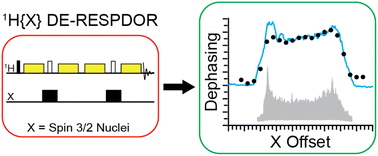Accelerated acquisition of wideline solid-state NMR spectra of spin 3/2 nuclei by frequency-stepped indirect detection experiments†
Abstract
73% of all NMR-active nuclei are quadrupolar nuclei with a nuclear spin I > 1/2. The broadening of the solid-state NMR signals by the quadrupolar interaction often leads to poor sensitivity and low resolution. In this work we present experimental and theoretical investigations of magic angle spinning (MAS) 1H{X} double-echo resonance-echo saturation-pulse double-resonance (DE-RESPDOR) and Y{X} J-resolved solid-state NMR experiments for the indirect detection of spin 3/2 quadrupolar nuclei (X = spin 3/2 nuclei, Y = spin 1/2 nuclei). In these experiments, the spectrum of the quadrupolar nucleus is reconstructed by plotting the observed dephasing of the detected spin as a function of the transmitter offset of the indirectly detected spin. Numerical simulations were used to investigate the achievable levels of dephasing and to predict the lineshapes of indirectly detected NMR spectra of the quadrupolar nucleus. We demonstrate 1H, 31P and 207Pb detection of 35Cl, 81Br, and 63Cu (I = 3/2) nuclei in trans-Cl2Pt(NH3)2 (transplatin), (CH3NH3)PbCl3 (methylammonium lead chloride, MAPbCl3), (CH3NH3)PbBr3 (methylammonium lead bromide, MAPbBr3) and CH3C(CH2PPh2)3CuI (1,1,1-tris(diphenylphosphinomethyl)ethane copper(I) iodide, triphosCuI), respectively. In all of these experiments, we were able to detect megahertz wide central transition or satellite transition powder patterns. Significant time savings and gains in sensitivity were attained in several test cases. Additionally, the indirect detection experiments provide valuable structural information because they confirm the presence of dipolar or scalar couplings between the detected nucleus and the quadrupolar nucleus of interest. Finally, numerical simulations suggest these methods are also potentially applicable to abundant spin 5/2 and spin 7/2 quadrupolar nuclei.



 Please wait while we load your content...
Please wait while we load your content...